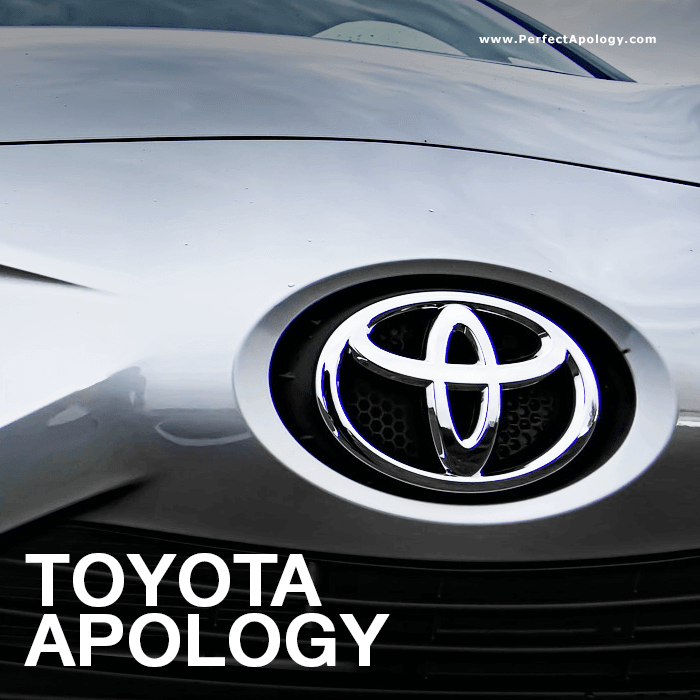Toyota Apology & Recall Case Study
From the end of 2009 to the beginning of 2010 a major Toyota recall was initiated for three separate but related problems with their automobiles.

The first two recalls, facilitated by the National Highway Traffic Safety Administration (NHTSA), were intended to address a large number of reports about unintended acceleration in some of the their vehicles.
The November 2, 2009 Toyota recall focused on the driver's side floor matt that reportedly trapped the acceleration pedal.
On January 21, 2010, the second recall focused on mechanical failures leading to the sticking of the acceleration pedals.
A third Toyota recall was initiated in February 2010 to address problems related to the anti-lock breaking system.
Since 2000, a total of 37 deaths were suspected of being caused by these problems.
In total, Toyota recalled over 5 million vehicles for the floor matt problem, close to 3 million to address the accelerator pedal issues. These recalls were extended to include millions of vehicles in Europe to produce a total world-wide recall surpassing 9 million cars and prompted the Toyota apology reviewed below.
The Toyota Apology
Akio Toyoda, the president of the company, issued the following Toyota apology and statements for the recalls:
I extend my condolences from the deepest part of my heart.
I am deeply sorry for any accidents Toyota drivers have experienced. I sincerely regret accidents.
Truly speaking, truly, I feel very sorry for the members of the Saylor family who ended their life with Toyota vehicles. I extend the condolences from the deepest part of my heart.
All the Toyota vehicles bear my name. When the cars are damaged, it is though I am, as well.
Toyota has, for the past few years, been expanding its business rapidly. Quite frankly, I fear the pace at which we have grown may have been too quick.
I regret that this has resulted in the safety issues described in the recalls we face today, and I am deeply sorry for any accidents that Toyota drivers have experienced.
I feel deeply sorry for those people who lost their lives or who were injured by traffic accidents, especially those in our own cars. I extend my sincerest condolences to them, from the bottom of my heart.
Akio Toyoda
Toyoda added an additional step to the recall process to improve customer safety—changes included: 1) a 'quality advisory group', 2) a 'product safety executive', and 3) they will require a team to 'actually drive the cars....'
Toyoda goes on to say,
We will listen to customer complaints humbly.
Ayako Doi, a Japanese journalist commenting on the Toyota apology in a major PBS newscast, explained the meaning of the company's efforts:
Apologies are very, very important in Japan, whether it's a—it's a corporate scandal, the problems like we are facing now, or athletes not living up to their expectation of the country in the Olympics ...apologies makes society run.
Of course there have been many scandals and misconducts and failures of Japanese corporations.... Every time the president or the chairmen of the companies go in front of the camera and bow deeply, 45 degrees, to express their sincere feelings, contrition, apologies, whatever, without that, corporations cannot survive.
It's -- it's that important in Japan.... It usually happens in press conference settings. And the press, the photographers will almost demand that, please, give a deep apology to express the -- express your feelings to the Japanese public. It's just customarily done so....
(Crying) has happened before. I don't know whether the Japanese are more emotional people than the Americans or what, but it happens.
And it's seen as an expression of their feelings. And people expect that. People expect that to happen, especially in the plane crash cases. Or, in this case, it's auto companies, and people have died...
I don't have any reason to believe that Mr. Toyoda's tears today -- today or yesterday were not sincere. But it helps soothe the public feelings."
Toyota Recall & Apology Review
The most obvious shortcomings with the Toyota apology, despite the bowing and crying, is what he decided to apologize for and how he framed the subject of his regrets and remorse,
I sincerely regret accidents...I feel very sorry for the members of the Saylor family...I regret that this has resulted in the safety issues.
These expressions of 'regret' for the consequences of the company's mistakes (and negligence) do not amount to a sincere apology, nor do they constitute acceptance of responsibility for the failure to immediately determine the cause of the accidents.
Toyoda and other company executives made a conscious decision when dealing with the Toyota recall crisis to prioritize profit maximisation and the company's reputation rather than public safety when they intentionally downplayed and then delayed the recalls.
Nowhere in the Toyota apology and in Toyoda's expressions of regret does he admit (or accept responsibility for) the specific acts that led to the deaths of these people -- he simply 'regrets' the loss of life, but who wouldn't?
There is nothing in particular that distinguishes the sorrow and anguish he feels from what most of us feel for these same deaths.
The only reference to something approaching responsibility is the general reference in the apology speech to the company's poor decisions to prioritize speed over quality—that was about as far as his lawyers were willing to go.
The Toyota apology through Toyoda's admission manages to retain a pretty healthy (litigation avoiding) distance from the actual mistakes he should have acknowledged and apologized for.
According to one of many New York Times reports on the hearings, when questioned by committee members one of Toyota's most senior executives in the United States (Mr. Inaba) admitted that the company had knowledge of similar problems related to sticking pedals in Europe long before similar accidents were reported in the US (up to one year before).
This was an important admission, because prior to this statement the company's executives stated that the problems of sticking pedals was uncovered sometime in October (about four months ago).
Inaba testified that,
...we did not hide it. But it was not properly shared. We need to do a much better job sharing what we knew in Europe with the United States to see if there is any danger to American consumers.
Inaba testified that the US team,
...was not aware of or not informed of the recalls in Europe
These are obviously two completely different mistakes—one is an organizational failure, the other an intentional or criminally negligent failure to inform other parts of the organization for fear of the impact on sales and the costs of a considerably more extensive recall.
No apology was offered for the more serious and fatal errors in judgement that led to the Toyota recall.
Consider the angry comments by members of the various committees responsible for conducting hearings on Toyota's deficient recall strategies.
Toyota had three responses: First, blame the driver. Second, blame the floor mat. Third, blame a sticky gas pedal. And NHTSA—without doing any meaningful independent review—accepted Toyota's explanations...Car makers have entered the electronics era, but NHTSA seems stuck in a mechanical mind-set.Rep. Henry A. Waxman (Chairman of the Energy and Commerce Committee)
This agency is a cop. It's a policeman. They should act like one. If people don't like it, too bad..., I don't know if [NHTSA] has been beaten down or it just doesn't care.Joan Claybrook (former NHTSA administrator)
NHTSA failed the taxpayers, and Toyota failed their customers.Rep. Edolphus Towns (Chairman of the Oversight and Government Reform Committee)
These comments reveal the number of demands being placed on individuals well beyond those responsible for the Toyota recall when demanding apologies.
One of the more damaging pieces of evidence against the company was a record of a sales report delivered to senior Toyota executives (including Inaba) informing them that the company saved about $100 million by recalling only the floor mats (the initial suspect in the acceleration problems) instead of the entire cars to redesign the acceleration pedals.
Representatives on the committee called the sales presentation one of the most embarrassing documents they had seen.
Herein lies another problem with the Toyota apology—it focused on the loss of life, but not other obvious errors that could easily be connected to those losses, like not sharing crucial information to American officials at the National Highway and Traffic Safety Administration (NHTSA) about possible problems.
It would be clear to anyone working through the transcripts of the hearings that the most serious mistake, in addition to the faulty design, was the intentional failure to communicate the dangers once they were uncovered in Europe.
That error has never been explicitly acknowledged, because it would run the risk of turning what is essentially a recall problem into something approaching a criminal offence.
Transportation Secretary Ray LaHood called Toyota "safety deaf."
Company officials responsible for managing the Toyota recall crisis continued to blame the problem on floor mats instead of the actual design of the pedal, so there are obvious questions about whether Toyota executives actually took full responsibility, acknowledged the damage, and quickly made changes that resolved the problem and prevented this from happening in the future.
But that initial round did not resolve the problem and did not acknowledge the mistakes.
The company has since issued another Toyota apology for its emphasis on sales rather than security, but in a sense this came too late.
Most of us usually get only once chance to issue the perfect apology, and if that opportunity is missed (for indefensible reasons) it becomes increasingly more difficult (very quickly) to craft an apology that can effectively address the initial mistake and all subsequent errors committed in the effort to sidestep the real problem.
A quick review the transcripts from the hearings would confirm the failure of those responsible for managing the Toyota recall problem to explicitly accept responsibility for the consequences of their many errors.
It is easy for most of us to understand how a company can fall prey to a poorly designed acceleration system, but hiding the evidence from other customers, and then rejecting the more expensive recall because of its impact on profits and reputation, is a considerably more difficult mistake to accept or fix.
One of the more surprising parts of the Toyota recall crisis story and the Toyota apology that followed was the reaction by Paul Atkinson (from the Toyota Council of Dealers) who was apparently annoyed by the disrespectful treatment of CEO Toyoda. Atkinson then took it upon himself, despite the evidence, to apologize to Toyoda and Inaba for being treated so poorly,
We apologize for the embarrassing way some members of Congress treated you these last few days. If Bill Gates had been treated the way you were in your country, imagine what would happen. We sincerely apologize.Paul Atkinson
Toyota Apology Rating
In sum, despite being a widely practiced cultural phenomenon, the content of the official Toyota apology did not satisfy the requirements for an effective apology.
Damaged by the angry responses from Congressional leaders, and in the absence of several key components (e.g., accepting full responsibility; compensation), the company failed.
But so did officials within the NHTSA who deserve to be evaluated as well for their failure to accept any responsibility—throwing it back to Japanese culture of secrecy. But it is their responsibility to find and fix safety issues and not to rely exclusively on the word of automotive executives who obviously have competing interests.
APOLOGY RATING → 4/10 for the Toyota Apology
APOLOGY RATING → 0/10 for the NHTSA non-apology.
Check out other case studies on public apologies and learn what questions to ask yourself before issuing one.


